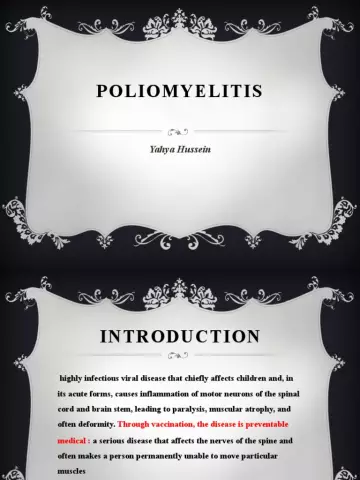- Author Rachel Wainwright [email protected].
- Public 2023-12-15 07:39.
- Last modified 2025-11-02 20:14.
Labyrinthitis

Labyrinthitis is a disease characterized by damage to the internal peripheral parts of the sound and vestibular analyzers. Often, this disease occurs with acute inflammation of the middle ear, middle ear tuberculosis, or is the result of an injury.
The symptoms of labyrinthitis and the course of the disease depend on the concentration of the process in the inner ear. Mostly labyrinthitis is triggered by an upper respiratory tract infection (influenza, ARVI). Sometimes the condition results from a middle ear infection. Rarely, labyrinthitis can be caused by a bacterial infection.
Types of labyrinthitis
The disease is subdivided into the following types:
- Hematogenous labyrinthitis. In this form of the disease, infectious agents enter the inner ear along with the blood stream.
- Purulent - leukocyte infiltration of endo- and perilymph.
- Diffuse purulent or serous labyrinthitis, which can spread to all parts of the bone labyrinth.
- Necrotic, in which areas of necrosis appear on the bone labyrinth and soft tissues.
- Meningogenic, arising from meningitis. In this form of the disease, the causative agent of infection penetrates from the subarachnoid space through the snail's water supply.
- Limited labyrinthitis, in which a certain area of the wall of the bone labyrinth is damaged.
- Serous, in which there is an increase in the amount of perilymph and the endosteum of the labyrinth swells.
- Acute purulent or serous labyrinthitis, in which dysfunction of the inner ear occurs suddenly.
- Traumatic, resulting from trauma (with a gunshot wound, fracture of the base of the skull).
- Chronic labyrinthitis, when the dysfunction of the inner ear occurs gradually.
Labyrinthitis symptoms
As mentioned above, the symptoms of labyrinthitis and the severity of the course of the disease largely depend on the localization of the process.
As a rule, at the initial stages of the disease, irritation of the labyrinth is noted, which manifests itself in the following symptoms: nausea, dizziness, tinnitus, hearing loss, vomiting, balance disorder. The intensity of the vertigo depends on the form of the labyrinthitis. Balance disorders are observed both at rest and when walking.
With serous labyrinthitis, pathological changes such as the formation of edema in the soft parts of the labyrinth and the appearance of exudate are observed. If the labyrinthitis passes without complications, then the exudate is gradually resorbed.
With limited labyrinthitis, the presence of a fistula is often observed, which is mainly located on the horizontal canal. With a purulent form of the disease, a symptom of labyrinthitis is an increase in body temperature. And with diffuse purulent labyrinthitis, a complication such as complete hearing loss often occurs.
If the disease is accompanied by meningitis and cerebellar abscess, then the diagnosis of labyrinthitis is extremely difficult.
With serous or limited labyrinthitis, partial preservation of the functions of the vestibular and cochlear apparatus is characteristic. With a complete disorder of their functions, we can talk about a diffuse purulent labyrinthitis.
Diagnostics of the labyrinthitis
The examination of the patient is carried out after he goes to the hospital with certain complaints. Sometimes special tests are used to identify the cause of dizziness, but if this does not help to establish the exact cause, as a rule, an additional examination is prescribed.
In the diagnosis of labyrinthitis, the following studies play an important role:
- Magnetic resonance imaging and computed tomography. Using these methods, you can see if there is any pathology of the brain.
- Electronystagmography. With the help of electrodes, the movement of the eyeballs is recorded. If the dizziness is caused by damage to the inner ear, then the eyeballs make certain movements. If the dizziness is caused by damage to the central nervous system, then the eyeballs make different types of movements.
- Hearing testing is another method for detecting hearing impairment. These include the BAYER and BSER methods, the auditory brainstem test response, which can help determine if the nerve from the inner ear to the brain is working normally.
- Audiometry is a method that helps to determine how well a person can hear.
Labyrinthitis treatment

After the diagnosis of labyrinthitis and confirmation of the diagnosis, the patient is hospitalized without fail. When treating labyrinthitis, the patient should be under the close supervision of the attending physician. The patient is recommended complete rest and a light diet (salt-free and anhydrous). To reduce the pressure inside the labyrinth, the patient is prescribed urotropine and glucose. The main drugs in the treatment of labyrinthitis are antibiotics, the choice of which depends on the sensitivity of the middle ear flora to them.
In the serous form, the treatment of labyrinthitis consists in restoring the function of the ear and preventing the transition of this form to purulent.
In acute purulent form of labyrinthitis, the patient should be provided with a normal outflow of pus. This is done by separating new tissue from the pre-auteine space.
With a limited labyrinthitis, for a complete cure, it is necessary to ensure the healing of the fistula with connective or bone tissue. As a rule, for this purpose, a surgical operation is performed, when a pathological focus is removed from the temple area.
For the treatment of hematogenous and meningogenic labyrinthitis, broad-spectrum antibiotics are prescribed.
Prevention of labyrinthitis
For the prevention of this disease, it is necessary to take appropriate measures to prevent common infectious diseases, as well as timely treat any inflammation of the middle ear.
YouTube video related to the article:
The information is generalized and provided for informational purposes only. At the first sign of illness, see your doctor. Self-medication is hazardous to health!






